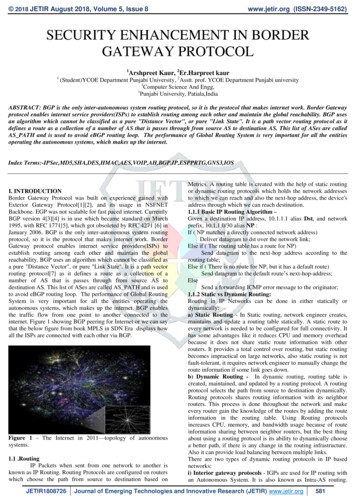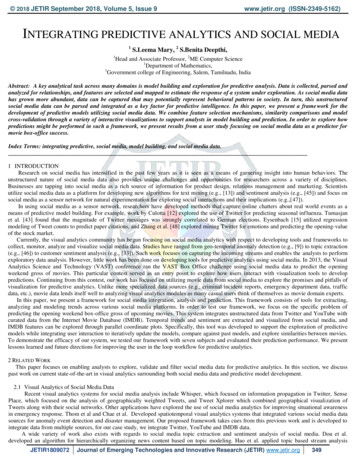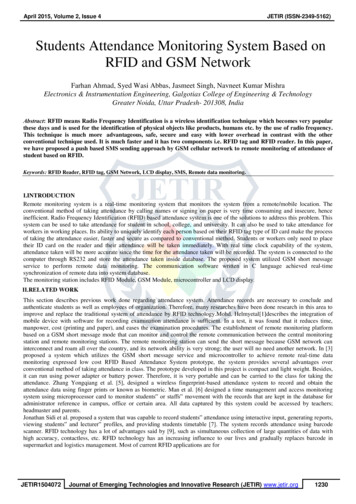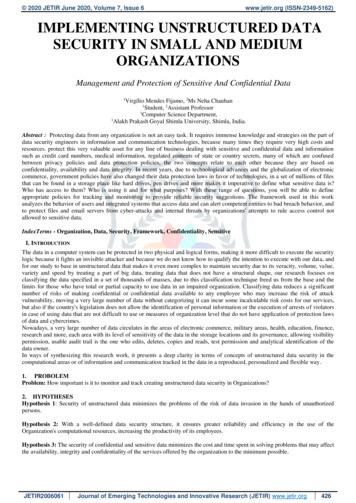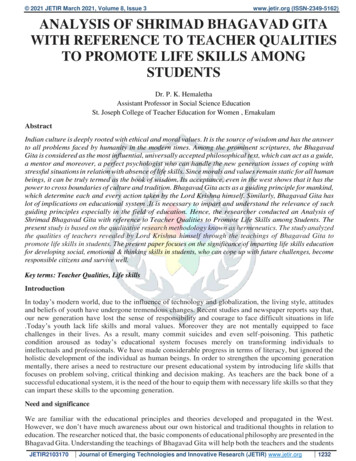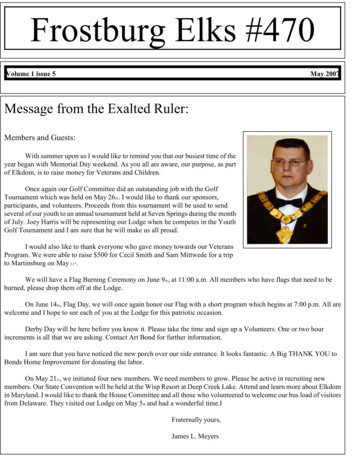
Transcription
2019 JETIR June 2019, Volume 6, Issue 6www.jetir.org (ISSN-2349-5162)Web-based Digital Resources and Services in LibraryEnvironmentNaveen Kumar B.M.Chief Librarian,Ramaiah College of Law,MSR Nagar, MSRIT Post, Bangalore-560054.Shekarappa SLibrarianRamaiah College of Law,MSR Nagar, MSRIT Post, Bangalore-560054.Abstract1. IntroductionInformation and Communication TechnologyThe web technology and Internet has changedhas revolutionized the information handling activitiesthe way of information is stored, retrieved andin the libraries and information centers during the pastcommunicated in the libraries. As more libraries movefew years. particularly World Wide Web hastowards providing their services in a digitalrevolutionized the way people access information, andenvironment, the improved access to remote libraryhas opened up new possibilities in areas such as digitalcollections is making the use of electronic informationlibraries, Web has been emerging as formidable moderesources more realistic and more attractive. Librariesof information, communication in delivery and accessuse their websites to provide services to users withoutof knowledge resources has become more convenient,their physical presence. Some libraries provide onlyeconomical due to the advent of web- technology inminimal information about their collections andall walks of human life so Libraries and their resourcesservices, while many offer more Web OPACs, accesshave partially moved to the virtual world of theto online databases, e-books, virtual reference service,Internet. As a result, library users can access theelectronic reserves, Web-based user education tools,resources from outside the physical library. In anvirtual tours, etc. The Due to the tremendous growtheffort to reach users accessing the library via theirand continuous development of technology, the role ofcomputers, many libraries and library consortia arelibrary becomes more responsive in making the usersextending their services to include virtual reference.techno-savvy. Technological developments haveAs more libraries move towards providing services inaffected not only the formats and sources of thea digital environment, the improved access to remoteinformation, but also how and where to provide librarylibrary collections is making the use of electronicservices. Libraries and their resources have partiallyinformation resources more realistic and moremoved to the virtual world of the Internet. With theattractive. Traditional online services had transformedamount and diversity of information available on thethemselves into internet-based online services usingInternet and in databases constantly increasing, theweb-based technologies.lack of organization on the web, the demands of userswho want quick, clear answers in response to anKeywords: E Services, Digital Library, Library Page,information need, and (sometimes) the lack of skillsWeb model, Digital Resources.JETIRDG06005Journal of Emerging Technologies and Innovative Research (JETIR) www.jetir.org36
2019 JETIR June 2019, Volume 6, Issue 6www.jetir.org (ISSN-2349-5162)among users to find information, there is an evengreater need for reference services today.2. What is web based library services?Web based Library services means that libraryusers can obtain services whenever they need themand other databases are accessible twenty four hoursper day (except for scheduled maintained andoccasional system failures) from anywhere onFig 1: web services modelcampus.Web Services are self-contained, modular3.1.Access to Databaseapplications that can be described, published, located,and invoked over a network, generally, on the Web.“A set of working definitions for Web-basedservices linking to high quality, reviewed resourcesfor researchers and other interested parties”Several publishers today offer web-based,intranet solutions for providing local access to dge Scientific Abstract and Institute forScientific Information. Journal publishers have alsobegun to offer similar situation, for example Elsevier,3. Web-based Library Services based onDigital Resourceslibraries can take advantage of these developmentsThe digital resources and associated technicalinfrastructure is only a means to generate serviceskeeping its potential users in mind. Like printedresources are used in traditional libraries to generateservices by the library staff, the digital resources areused to generate services using software driven webbased interfaces. Computer programs substitute fortheintellectuallydemandingfor electronic version of their journals. Large R&Dtasksthataretraditionally carried out by skilled professionals.and provide desktop access to key database andelectronic publications to their users. Apart from theexternally purchased databases, libraries have theirown collection of CD-ROM databases mounted ontheir CD server/tower. Online database vender such asDialog, Lexis-Nexis, and ERIC are delivering theirdatabase over internet. So a library which subscribesto these databases can now easily access them overWeb.Activities that require considerable mental activities,like reference service cataloguing and indexing,seeking information, etc. are performed by computerprograms through web-based interface.3.2.CD ROM to Web-based Indexes andDatabasesAvailability of CD ROM in late 1980s, as amedia with high storage capacity, longevity, and easeof transportation triggered production of several CDROM information products which were earlieravailable through online vendors or as conventionalabstracting and indexing services in printed format.Some of the important secondary services includingJETIRDG06005Journal of Emerging Technologies and Innovative Research (JETIR) www.jetir.org37
2019 JETIR June 2019, Volume 6, Issue 6www.jetir.org (ISSN-2349-5162)“Guide to Current Periodical Literature” (H.W.based library resources. An informative home pageWilson) discontinued their print version in favour ofintroduces users to helpful information about theCD ROM version which had improved functionalitylibrary, its collections, and services. This order ofin terms of search and browsing interfaces. Theaccess is a good opportunity to distinguish betweenlibraries are witnessing yet another migration fromthe catalog and other electronic indexes and databases.bibliographic databases on CD ROM to web-basedWebPAC is welcome with open aims because: thebibliographic databases akin to the one that wasWeb interface is familiar and graphics aid navigation.witnessed earlier from print based secondary servicesThe user can click complex subject, or other, headingsto CD ROM databases. This phenomenon has furtherless typing is good.been fuelled with availability of web-interfaces formost of the online search services. The web-basedinterfaces provide several advantages to users that areeither not possible or not yet available on CD ROM.Mostweb-basedbibliographicdatabasesuseSome of the Web Based OPAC sites are hereName of web OPAChyperlinks and other facilities possible in a webThedocuments including link to the full-text of articles toCongressa publisher’s web site. Several bibliographic databasesCataloghave discontinued their CD ROM version in favour ofTheweb-based version. Besides advantages mentionedCatalog -OPAC-97above, migration to web-based services open-upHYTELNETresources to remote users.World Wide WebLibraryof http://lcweb.loc.gov/cataOnline log/BritishLibrary http://opac97.bl.uk/.ongives http://www.lights.com/wGeographicalOPAS’s - On Line Public Access Catalogues,Vendorthe http://www.lights.com/hytelnetWebCATS3.3.OPACOPAC sitesindex, ebcats/.indexandform an important part of many digital library’slibrary-type index:collections. It allows users to search for theCHESWEB-bibliographic records contained within a library’sandcollections. Now days, some OPAC also provideCatalogaccess to electronic resources and databases, inZ39.50addition to the traditional bibliographic recordsNumber of institute , 50/.British http://www.chester.ac.ukInternational / smilne/libs.htmGateway— http://lcweb.loc.gov/z39colleges3.4.OPAC to WebPACWhen remote access to the library cataloganduniversities catalogsROGER-UCSD's local http://roger.ucsd.edu/meant a telnet connection, users had little incentive toonline catalog:visit the library Web page. As WebPAC’s matured toULTAS Catalog: telnetthe point where the interface was , many libraries phased out their dumbSILOterminal OPACs. The library Web site then became aRSA: telnetcatalogfrom http://universe.rsa.lib.il.uc:24/more logical gateway to the catalog and other WebJETIRDG06005Journal of Emerging Technologies and Innovative Research (JETIR) www.jetir.org38
2019 JETIR June 2019, Volume 6, Issue 6CARL systemhttp://www.carl.org/cinfo.htmlwww.jetir.org (ISSN-2349-5162)4.1.Newsletter ServicesIt is very good service to the users, listingavailable Internet services, sites, new addition,4. Internet Subject Gatewayspublications, useful like Conference, Workshops,Subject based Information Gateways areTraining and Fellowship programs. A catalog ofsubject entrances (clearing houses) to quality assessedInternet base information sources is useful assets forInternet resources. This can be contrasted withall R&D libraries if given at regular intervals throughgateways where resources are arranged according toe-mail or they can host it in their website.where they are physically placed or "geographically"like W3 servers or according to what type of resource4.2.Frequently Asked Questions (FAQ)they are, such as InterNIC. Compared to commonFAQ stands for Frequently Asked Questions.link-lists SBIGs are labor intensive, but gives theA compilation of Frequently Asked Questions andadvantage of a quality-assessed collection, withtheir answer is referred to as a FAQ list or FAQ article.standardized descriptions that gives the user aFAQs are compilations of information which are thepossibility to judge the relevance of the resources.result of certain questions constantly being askedhence the name FAQ. There are thousands of FAQsName of GatewaysWeb addresson the World Wide Web. Ask ERIC is an InternetWWW Gatewayshttp://www.actlab.utexasquestion answering services run buy the ERIC.edu/gateways.htmlClearinghouse on Information and Technology atSubjectGateways, http://www.ull.ac.uk./ull/Syracuse University, New York. Since it began inElectronic Journals and webres.html1994 it has answered more than 2 million education-Search toolsrelated questions from around the world. It now offersTrinity College Library http://www.tcd.ie/Librara new features for ERIC/IT, an abstracts in processWWWdatabase of abstracts that are awaiting final editing toResourcesfor y/gateways.htmLibrary User:be loaded on to the ERIC database updated weekly,Galaxy-The professional's http://galaxy.einet.net/gathe in process database offer 15 searchable fields andguide to a world of laxy.htmleach record contains bibliographic information and aninformationabstract of document and journal articles ERIC/IT hasAustralianLibraries ucts/alg/based http://www.lub.lu.se/desi4.3.WebcastingWebcasting which is another example of PushInformation bTechnology is defined as the "Pre-Arranged updatingWWW/irn/pinakes/pinakof news, weather or other selected information on anes.html.Internet user's desktop through periodic and generallyhttp://infomine.ucr.edu/unobtrusive over the WWW". In other words, pushMain.htmltechnology or webcasting is a method of informationINFOMINEdelivery across the web that pushes information to thescreens of user’s computer. It is an webcasting wasJETIRDG06005Journal of Emerging Technologies and Innovative Research (JETIR) www.jetir.org39
2019 JETIR June 2019, Volume 6, Issue 6www.jetir.org (ISSN-2349-5162)introduced by the PointCast Network in 1996.Presently most of the webcasters concentrate on news5. Modern Web-based Library Services:delivery.5.1.Virtual Library ToursSeveral library web sites facilitate virtual4.4.White Board EnvironmentIn a whiteboard environment, there can beguide to the physical facilities including collections,many users connected to discuss on a topic and it isservices and infrastructure available in the librarydifferent form the newsgroup in the sense that thethrough their web sites. The combination of thecomputer screen serves as a whiteboard and the userfollowing three web-based interfaces are used tocan draw figure using the mouse and post message/facilitate the virtual library tours.explanation in the comment box that appearssimultaneously with the whiteboard for other users to5.2.Library Maps and Floor plansview. It is multi-user Java chat and drawing programMost library web sites provide library layoutsand so the systems that are connected must be enabledand floor plans to guide users to physical location ofto download Java applets.facilities and services along with link to relevantinformation Client-side image maps are used to makevarious parts of floor plans as clickable image maps.4.5.TelnetThe Telnet service allows user to log in toAn example can be seen at the Central Library Homeanother computer somewhere on the Net. ThroughPageoftheCentralLibrary,IITDelhiTelnet a user can execute telnet commands on tmlatlocal computer to start a login session on a remotecomputer. This process is also called ‘remote login’.Some of common uses of telnet service are: Using the computing power of the tiesAll physical facilities are listed throughcomputerselection boxes linked to the library floor plans along Using a software on the remote computerwith relevant description. Accessing remote computer’s database or5.4.Photographic Viewsarchive Reaching public access account Accessing to multiple telnet through telnetusing plug-ins like Quick Time and iPix are available Logging in to one’s own computer fromat a few library sites. Examples can be seen atanother computer.BotsfordA view of 360 photographic environmentGeneralHospitalLibrarysite http://www.botsfordlibrary.org/tour.html).6. Conclusion:Academic libraries in developed countries startedusing web technology to create home pages as startingpoints or as gateways for searching information aboutthe library. A home page reflects characteristics of anJETIRDG06005Journal of Emerging Technologies and Innovative Research (JETIR) www.jetir.org40
2019 JETIR June 2019, Volume 6, Issue 6www.jetir.org (ISSN-2349-5162)academic institution. It provides an opportunity to thelibrary to propagate its services and facilities to theacademic community worldwide. The home pages oflibraries are increasingly used as an integratedinterface designed to deliver detailed informationabout a library as well as to provide access to allcomputer-based services offered by a library. Besidesoffering information, the library web sites of academicinstitutions invariably hosts subject gateways orsubject portals that contains links to web resources forsubjects of interest to the institution. Most of theservices (modified or new) included in this article areoffered through the web sites of most of the academicinstitutions especially in developed world.Reference:[1] Lili, L. (2006). Leveraging quality web basedlibrary user services in the digital age. LibraryManagement, 27(6/7), 390-400.[2] Chowdhury, G. G. and Chowdhury, S. (2001).Information sources and searching on theWorldWideWeb.London:LibraryAssociation Publishing.[3] Berube,L.(2003).‘Digitalreferenceoverview: an issue paper from the NetworkedServices Policy Task Group.’ Available essed May 14, 2004.[4] Lankes,R.David.2002.TheDigitalReference Research Agenda. Available pdf. Accessed March 11, 2004.[5] Parsons, Anne Marie. 2001. Digital Reference:How Libraries Can Compete with AskaServices.DigitalLibraryFederationNewsletter January 15, 2001.JETIRDG06005Journal of Emerging Technologies and Innovative Research (JETIR) www.jetir.org41
to online databases, e-books, virtual reference service, electronic reserves, Web-based user education tools, virtual tours, etc. The Due to the tremendous growth and continuous development of technology, the role of library becomes more responsive in making the users techno-savvy. Technological developments have
